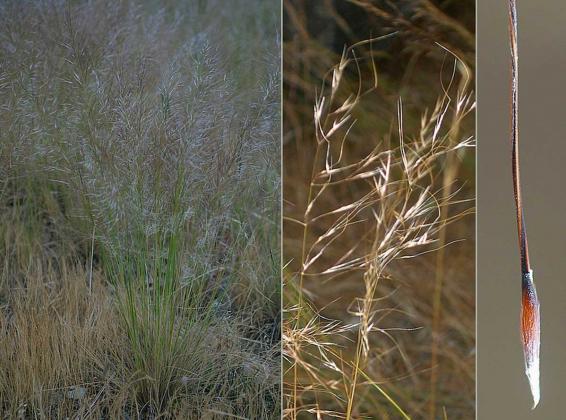
Rough Spear-grass
Austrostipa scabra
Slender tussock with erect stems to 50 cm tall. Slender tufted grass with flower stems to 60 cm tall. Fine inrolled leaves strongly up to 30 cm long. Short hairy leaf-collar (ligule). Seedheads to 30 cm with base often hidden by a leaf-sheath. Seeds are purplish then golden brown on maturity, and covered with white hairs. Bristle or awn sickle-shaped (falcate).
| Details | |
|---|---|
| Flora Type | Grasses |
| Former Scientific Name | Stipa scabra |
| Distinctive Features | The awn is a very fine sickle-shaped (falcate) to corkscrew shape. Leaves blades are very rough to the touch. Orifice of leaf-sheath is hairless and leaves are >15 cm long. |
| Biology | Perennial. Preferential grazing of other grasses can lead to flowering and seeding of Spear-grass and their long awns (bristles) can work their way into the skin, mouths and eyes of stock, and contaminate wool. |
| Native Status | Native |
| Flowering Time | Aug-Dec |
| Taxonomy | |
|---|---|
| Phylum | Tracheophyta (Vascular Plants) |
| Class | Magnoliopsida (Flowering Plants) |
| Order | Poales |
| Family | Poaceae |
| Genus | Austrostipa |
| Species | scabra |
Seed coloration and hairiness as well as the awns (bristles on seeds) are important identification features for Spear-grass species. A food source for seed-eating birds including finches. Also attracts moths and butterflies.
| Interesting Facts | |
|---|---|
| Similar Species | Two subspecies are recognised, separated by the length of their leaves and the presence or absence of hairs in the leaf-sheath. This native species can resemble the serious introduced environmental weed, Serrated Tussock Nassella trichotoma. A. scabra is finer. The seeds of Serrated Tussock are shorter and more rounded. |
| Native Status | Native |